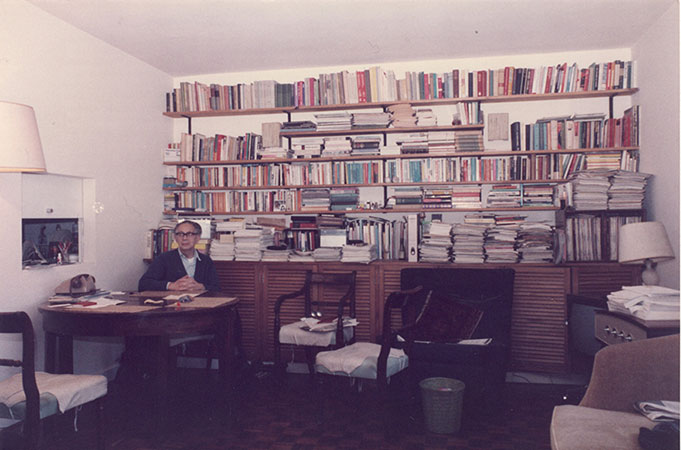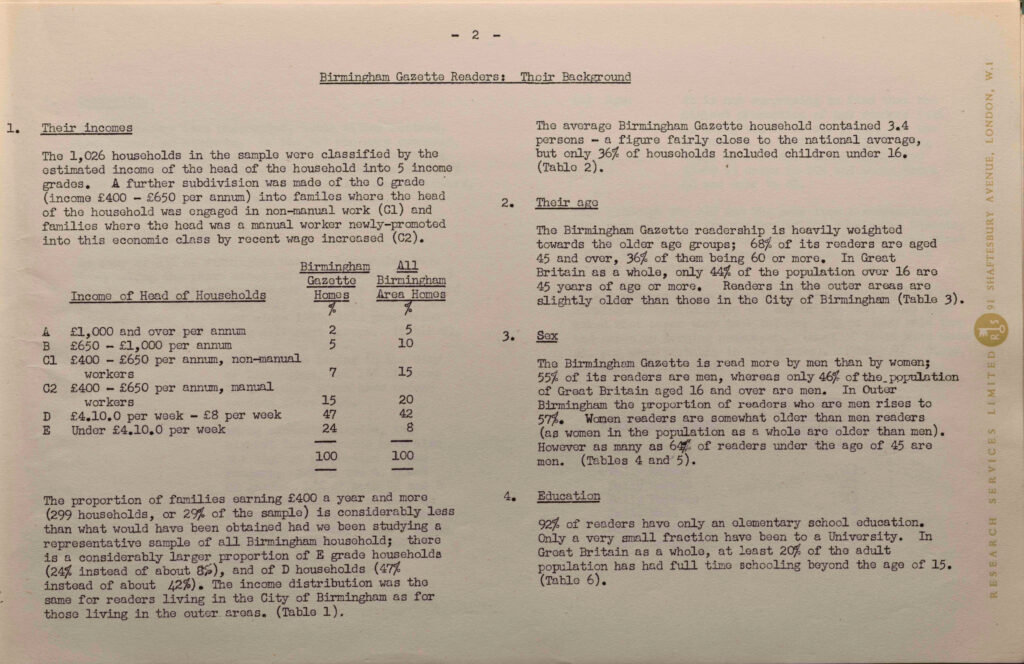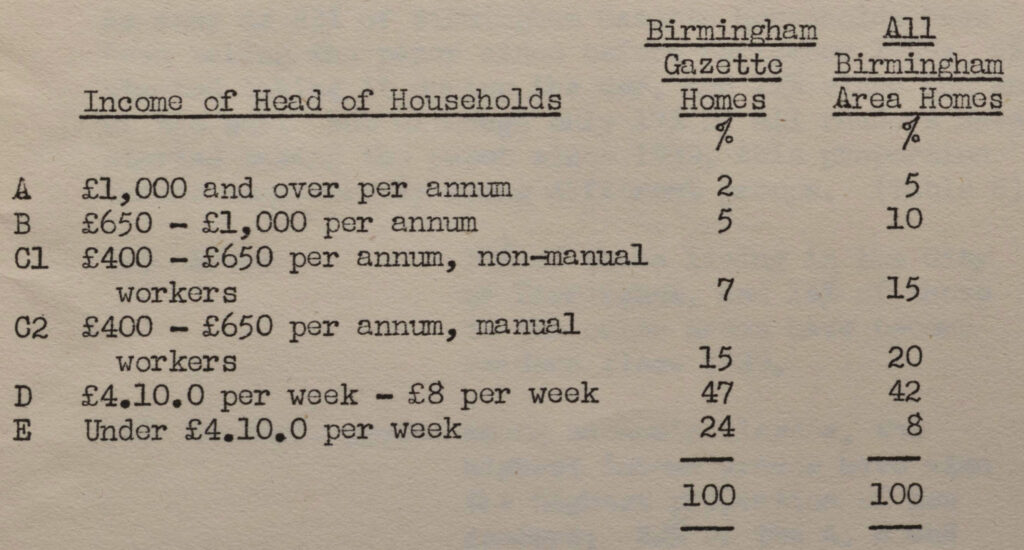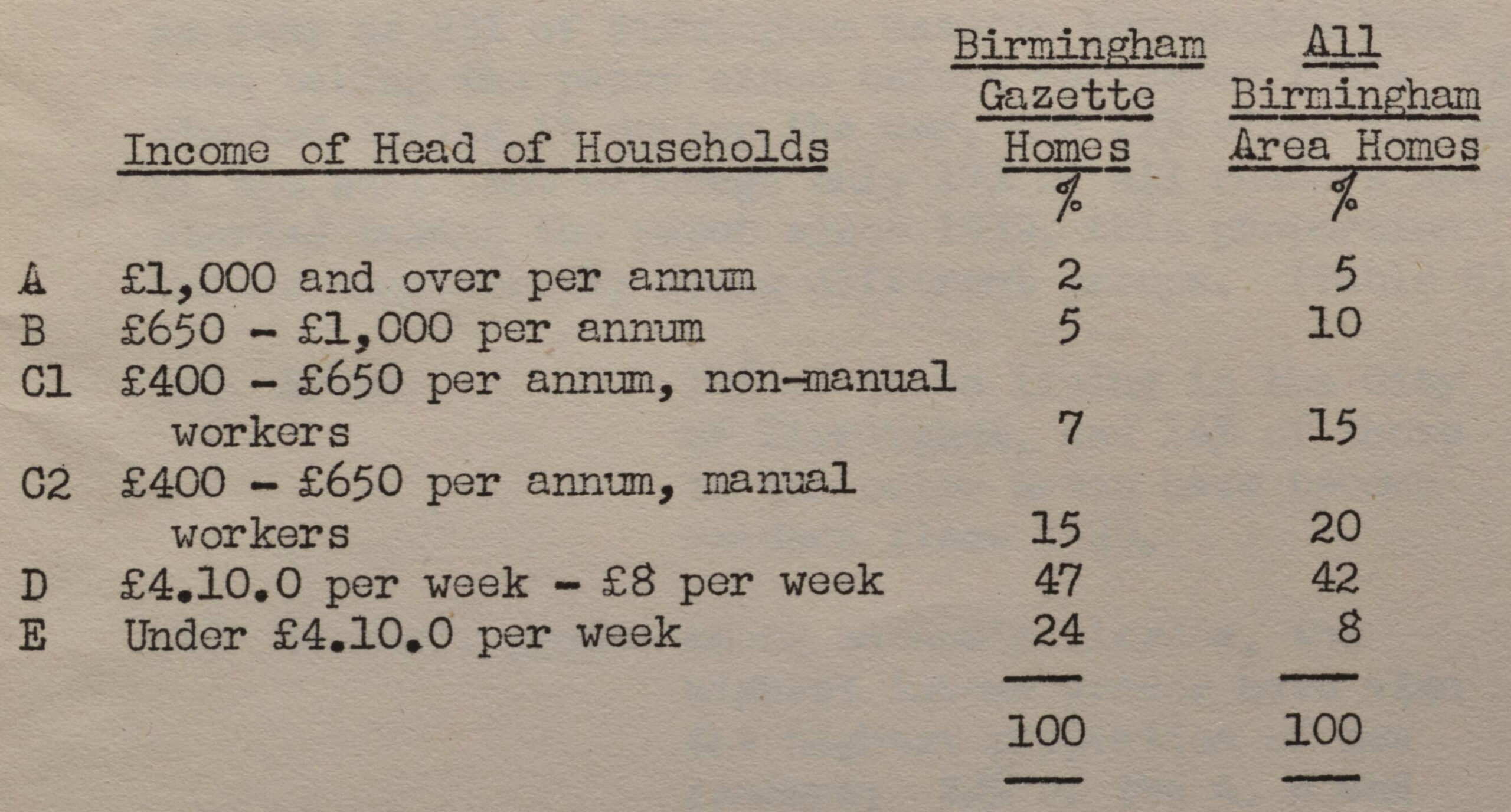The National Readership Survey’s (NRS) ABC1 social-grading scheme – with its signature split of the middling C-classes into the C1s and C2s – is the most widely understood and quoted of Britain’s social stratification schemes.
Since its launch in 1956, it has grown to eclipse its two main rivals: the official census-related social-grading scheme conducted by the General Registrar’s Office (GRO) since 1911;[1] and the various John Goldthorpe-inspired 1960s sociological schemes.[2] Yet the emergence of the ABC1 scheme is an interesting story and one contained within the papers of renowned market researcher Mark Abrams, held at the Churchill Archives Centre.

Determined to make advertising more of a science than an art, Mark Abrams (1906-1994) launched Research Services Ltd. (RSL) in 1946 as a market-research subsidiary of ‘big-five’ agency London Press Exchange (LPE). RSL played a key role in the development of the ABC1 social-grading scheme, which was officially launched by the NRS in April 1956.
Aimed at showcasing the class/income attributes of magazine and newspaper readerships, NRS was a joint venture between the Institute of Practitioners in Advertising (IPA), the Newspaper Publishers Association (NPA) and the Periodical Publishers Association (PPA).
The actual surveys were contracted to two advertising agencies: LPE, via RSL, and its biggest rival in Britain, the US-based J. Walter Thompson (JWT), via its market-research subsidiary, British Market Research Bureau (BMRB).
Both agencies had developed similar social-grading schemes in the 1930s – both using an ‘ABCDE’ scale for grading occupations based on income. And while it was the American agency that had the stronger claim for first use, the earliest surviving study using the ABCDE scheme in Britain was undertaken by LPE and can be found in the papers of Mark Abrams.[3] Published in December 1934, it records the social status of respondents in a private survey of ‘reader interests’ in the ‘national morning and London evening press’.[4]
By the 1956 launch of the NRS scheme, however, the ‘ABCs’ had become the ‘ABC1s’ thanks to the division of the Cs into ‘non-manual’ clerical C1s and the ‘skilled manual’ C2s. This was Abrams’s doing, as papers within Churchill Archives attest. The definitive moment when the split occurs can be found – without fanfare – between consecutively executed readership surveys undertaken by RSL.
In December 1950, in a survey of Manchester Guardian readers, the social grades were reported running A-to-E:
- A-£1000 and over per-annum (16% of those surveyed),
- B-£650-£1000 pa (22%),
- C-£400-£650 pa (34%)
- DE-under £400 pa (28%).[5]
Yet by May 1951 – in a near-identical readership survey of the Birmingham Gazette – the social grades were reported thus:
- A-£1000 and over per-annum (2% of readers, 5% of all in the Birmingham area),
- B-£650-£1000 pa (5% and 10%)
- C1-£400-£650 pa, non-manual workers (7% and 15%)
- C2-£400-£650 pa, manual workers (15% and 20%)
- D-£4.10.0-£8 per-week (47% and 42%)
- E-Under £4.10.0 pw (24% and 8%).[6]
An introduction explained that a ‘subdivision was made of the C grade… into families where the head of the household was engaged in non-manual work (C1) and families where the head was a manual worker newly promoted into this economic class by recent wage increased (C2)’ [sic].
And by page 4, RSL was already generating the banding that would become familiar within NRS surveys: that of the ABC1s banded together (to create the ‘middle-class’), with the DEs banded as the ‘working-class’, and the C2s treated separately.[7]
Was the split triggered by Birmingham’s postwar prowess as a manufacturing centre involving skilled shopfloor trades? No further explanation is given. Yet a 1952 RSL survey of the Liverpool Echo reverted to the ABCDE scheme, as did a September 1953 survey of Scottish newspapers and a September 1954 survey of The Times. The C1/C2 system was next adopted in the Spring of 1954 in a survey of children’s comics. Revealingly, this survey reported that 43% of C2 children read Beano compared to 50% of DEs and only 27% of ABC1s. Eagle was the only comic with a higher ABC1 readership than DEs.[8]


Yet, by the 1956 launch of the NRS scheme, the C1/C2 split had become embedded.[9] The launch itself was covered by The Times, which looked upon this ‘modern science of market research’ as an ‘indispensable tool of the trade’.[10] On publication, the initial survey was sold for £10/10s (£10.50). This ‘might be thought by the unsophisticated an expensive investment,’ claimed The Times.[11]
And it was a wise one: a 1963 memorandum drafted by BMRB reported that the scheme had gained wide acceptance among users both within and beyond the marketing industry and went on to claim that, in a comparative study of social classifications, this was the best scheme and that the IPA should ‘do everything in its power to encourage… general adoption’.[12]
By Robert Kelsey, PhD candidate, Churchill College.
Find out more
- Read our Mark Abrams research guide.
- Read a blog on Mark Abrams and researching perspectives of the future in 1970
- Read an interview with Robert Kelsey about his time at Churchill College
References
[1] From 1971 the census was conducted by the Office of Population Censuses & Surveys (OPCS), a merger of the GRO and the Government Social Survey Department. The OPCS was superseded by the Office for National Statistics in 1996.
[2] John Goldthorpe was Cambridge University’s first sociologist, appointed in 1960.
[3] JWT’s New York-based head of research Paul T. Cherington, a Harvard marketing professor, is credited with inventing the scheme in the mid-1920s. He adapted the American Census Bureau’s system of classification, with its account of both professional status and income not dissimilar to Britain’s GRO. See Stefan Schwarzkopf, ‘Statistics and the Public Sphere: Numbers and the People’ in Modern Britain, c.1800-2000 by Tom Crook, Glen O’Hara (eds) (Routledge, London, 2012), p.159.
[4] ABMS 2/1/1/1 ‘London Press Exchange’, p.1.
[5] ABMS 3/27, J.318, Readership survey of the Manchester Guardian by RSL, December 1950, p.2.
[6] ABMS 3/29, J.343. Readership survey of Birmingham Gazette May 1951, p.2.
[7] Banded thus to make them roughly equal in size. ABMS 3/29, J.343, p4.
[8] ABMS 3/29.
[9] The Times, 12 April 1956, p.17.
[10] The Times, 10 December 1956, p.7.
[11] The Times, 10 December 1956, p.7.
[12] BRMB memo dated 30 September 1963, ABMS 5/6 Class 1952-69 file, p1.


